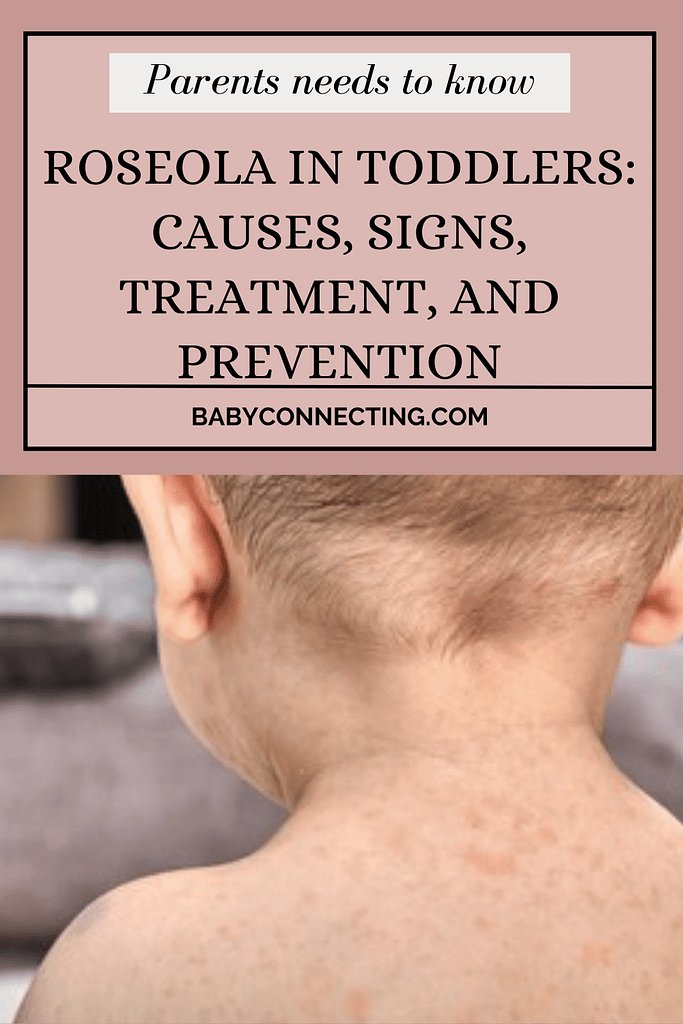“Understanding Roseola in Toddlers: Causes, Signs, Treatment, and Prevention”
Introduction:

Roseola is a common viral illness that affects many toddlers. While it can be concerning for parents, understanding its causes, recognizing the signs, and knowing how to manage it can help ease worries and ensure appropriate care for your child.
In this article, we’ll explore roseola in toddlers in easy language, backed by research references, to provide a comprehensive understanding of this condition and empower parents to effectively navigate it.
Causes of Roseola in Toddlers:
Roseola is primarily caused by the human herpesvirus 6 (HHV-6) and, less commonly, by human herpesvirus 7 (HHV-7). These viruses are highly contagious and spread through respiratory secretions, such as saliva or nasal discharge, as well as through close contact with infected individuals. Toddlers are particularly susceptible to roseola due to their developing immune systems and increased exposure to other children in daycare settings or playgroups.
Signs of Roseola in Toddlers:
Recognizing the signs of roseola is essential for prompt diagnosis and treatment. Common signs and symptoms may include:
1. High Fever:
Roseola often begins with a sudden onset of high fever, typically exceeding 103°F (39.4°C). The fever may last for several days and is often the first sign of illness.
2. Rash:
Once the fever subsides, a pinkish-red rash may appear on the trunk, spreading to the arms, legs, and face. The rash is typically non-itchy and may last for a few hours to several days.
3. Irritability:
Toddlers with roseola may become irritable or fussy due to discomfort from the fever and rash.
4. Other Symptoms:
Some children may experience additional symptoms such as sore throat, runny nose, cough, or mild diarrhea, though these are less common.
Treatment for Roseola in Toddlers:
Treatment for roseola is generally focused on relieving symptoms and providing supportive care. This may include:
1. Fever Management:
Use over-the-counter fever-reducing medications such as acetaminophen (Tylenol) or ibuprofen (Advil, Motrin) to alleviate discomfort and reduce fever. Follow dosing instructions carefully and consult a healthcare provider if you have any concerns.
2. Hydration:
Encourage your toddler to drink plenty of fluids, such as water, clear soups, or electrolyte solutions, to prevent dehydration and maintain hydration.
3. Comfort Measures:
Keep your child comfortable by dressing them in lightweight, breathable clothing and ensuring a comfortable sleep environment. Use lukewarm baths or cool compresses to help reduce fever and soothe irritated skin.
4. Rest:
Allow your toddler plenty of rest to help their body recover from the illness. Avoid excessive physical activity or exposure to other sick individuals until symptoms have resolved.
Prevention of Roseola in Toddlers:
Preventing the spread of roseola involves practicing good hygiene habits and minimizing exposure to infected individuals.
Key preventive measures may include:
1. Handwashing:
Encourage regular handwashing with soap and water, especially after coughing, sneezing, or coming into contact with potentially contaminated surfaces.
2. Covering Coughs and Sneezes:
Teach your toddler to cover their mouth and nose with a tissue or their elbow when coughing or sneezing to prevent the spread of respiratory droplets.
3. Avoiding Close Contact:
Limit close contact with individuals who are known to have roseola or other contagious illnesses, particularly during the fever phase when the virus is most contagious.
4. Disinfecting Surfaces:
Regularly clean and disinfect frequently touched surfaces and objects in the home, such as doorknobs, toys, and countertops, to reduce the risk of transmission.
Research References:
1. American Academy of Pediatrics. (2019). Roseola. HealthyChildren.org.
2. Fleisher, G. R. (2010). Evaluation of fever in infants and young children. UpToDate.
3. Whitley, R. J., & Kimberlin, D. W. (2005). Herpesviruses. In K. J. Ryan, & C. G. Ray (Eds.), Sherris medical microbiology: An introduction to infectious diseases (4th ed.). McGraw-Hill.
Conclusion:
Roseola is a common viral illness in toddlers, characterized by high fever followed by a distinctive rash. While it can be concerning for parents, most cases of roseola resolve on their own without complications. By recognizing the signs of roseola, providing supportive care, and practicing preventive measures to reduce the risk of transmission, parents can help their toddlers recover comfortably and minimize the spread of the virus to others. If you suspect your toddler has roseola or if you have any concerns about their health, consult a healthcare provider for guidance and appropriate management. With proper care and attention, most toddlers with roseola can recover fully and resume their normal activities in a short period.


